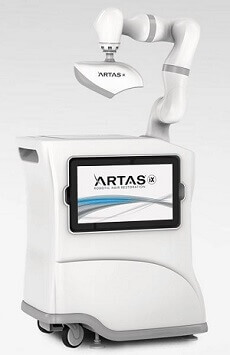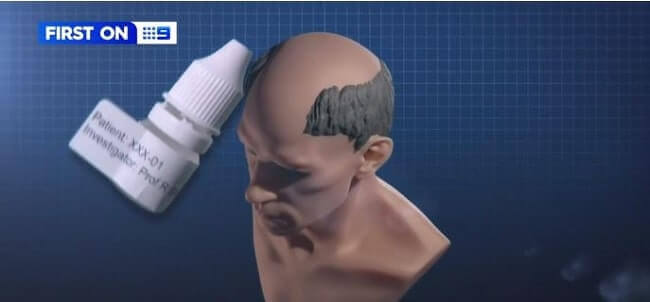
I originally wrote this post in 2013 and it was only two paragraphs long. It also had a dancing ARTAS robot video embedded.
At the time, the pioneering ARTAS® hair transplant robot from Restoration Robotics was all the rage. It was FDA-approved for robotic hair transplant surgery in 2011.
I forgot about this subject in recent years till I read a February 2023 article on “lunchtime” robotic hair transplants.
Note that Restoration Robotics undertook an IPO in 2017 (ticker “HAIR”), but then merged with Venus Concept (ticker “VERO”) in 2019. Venus Concept also makes the Neograft® hair restoration system.
Update: A great new video from Dr. Ken Anderson showing ARTAS robot-assisted hair follicle extraction.
ARTAS Graft Excision and Implantation
When I first covered this subject in 2013, I became convinced that automation was the future of follicular unit extraction (FUE) hair transplant procedures. At least when it came to AI- and algorithm-driven faster, more precise and higher quality graft excisions and extractions. And not susceptible to human technician error from fatigue or insufficient training.
Moreover, I wrote another post in 2014 about the future potential for ARTAS recipient site creation and even implantation. This was further confirmed by the highly regarded Dr. Robert Bernstein’s support and testing of this previously unimaginable concept. In 2018, he introduced robotic implantation of follicular unit grafts at the ISHRS 26th World Congress. Key quote:
“With implantation, three of the four aspects of a hair transplant (excision, site creation, implantation) have now been successfully automated. Only graft extraction is left as the remaining step.”
Note that the terminology of “excision” versus “extraction” is confusing for me, especially since I rarely cover hair transplants on this blog, Having said that, even the pros have issues in deciding on whether the “E” in FUE stands for extraction or excision.
Dr. Bernstein is currently using the latest ARTAS® iX Robotic System per his site. On there, he states that this robot automates two key steps in an FUE hair transplant: follicular unit graft harvesting and recipient site creation.
The ARTAS Robotic System allows surgeons to place new hair in the areas of the scalp that are currently thinning, while protecting the existing healthy hair in those regions. It does this via the use of advanced image-guided technology.
Update: In a March 2023 article on robotic hair transplant surgery, Dr. Jon Mendelson says something interesting about his new ARTAS:
“It’s really in the past year or so where the software upgrades, the algorithms, can measure the length of the hair, the depth of the hair, the orientation, and the angle of the hair and can harvest it, extract it and even implant it.”
Robotic Hair Transplant Popularity in 2023
I also wrote another ARTAS related post in 2014 when the company made its 100th robotic system sale. Quite an impressive accomplishment when considering that the ISHRS has around 1,000 surgeon members from around the world. And the more selective IAHRS currently has just 60 members. I would guess that over 300 hair restoration surgeons around the world must be using ARTAS by now?
On Venus Concept’s YouTube channel, they had quite a few ARTAS related videos in 2021, but none in 2022. In contrast, their Twitter and Instagram accounts both covered ARTAS hair transplants in 2023.
Robotic hair transplantation technology still has some issues that prevent its widespread adoption. Some of the decisions on how to use ARTAS must be made by the surgeon on a real-time basis.
Patients must shave their heads before the donor area hair follicles are harvested. This is required in order to overcome problems in those with curly hair. For African hair types that curl below the skin surface, a slightly larger punch needs to be used. If you have grey, white or blonde scalp hair, it must be dyed for the robot to visualize it correctly.
ARTAS graft extraction is also limited to the clearly defined permanent donor zone. In contrast, human surgeons can expand the donor area slightly when suitable. They can even use body hair from the nape of the neck, beard, chest and other regions.
Moreover, many patients refuse to be treated by a robotic system, and many surgeons still remain skeptical about its benefits. And some just prefer not spending a large amount of money on such technology.
So in summary, humans (both surgeons and technicians) are still crucial during a hair transplant procedure in 2023. In fact, experienced hair transplant technicians are in very short supply and can make a great living in this industry.
Cost
Unfortunately, the advent of robotics and automation in the hair restoration field does not seem to have reduced the price of a hair transplant. An ARTAS hair transplant will still cost most people at least $10,000 in the US. Many patients would probably become converts if the price of a robotic hair transplant was half that of a regular FUE hair transplant.
